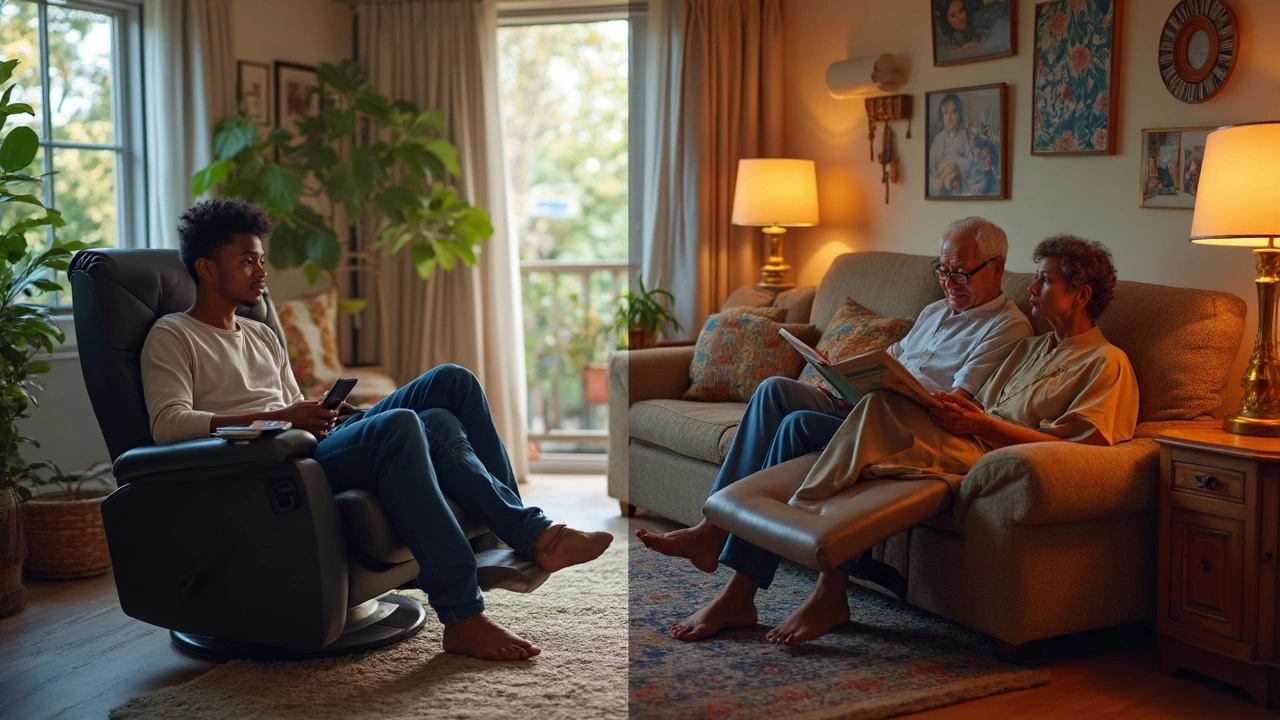If you're flipping between FlexSteel and Lazy Boy, you’re definitely not the only one. These two brands basically own the conversation when someone wants a recliner that's actually worth the cash. But are they really that different, or is it just hype?
Think about this—for years, Lazy Boy has been the go-to in American living rooms, almost like the Kleenex of recliners. But FlexSteel quietly keeps winning fans, mostly because people say their furniture just doesn’t quit, even with daily use. Is it true? We’re breaking down what actually matters: support, comfort, how long they last, and what you really pay for.
If your idea of a perfect chair is somewhere you can chill for hours without your back screaming, or if you’re hunting down a model that won’t start creaking after a year, keep reading. There’s a lot you won’t see in those glossy catalogs or in-store pitches. Let’s see what actually matters before you drop serious cash on your next favorite chair.
- What Makes FlexSteel Different?
- Why People Choose Lazy Boy
- Comfort, Support, and Durability Compared
- Money Talk: Which Gives More Value?
- Tips Before You Buy
What Makes FlexSteel Different?
People who’ve had a FlexSteel chair or sofa in the family will tell you—it’s the frame that sets them apart. The company’s been around for well over a century, and their signature Blue Steel Spring isn’t just a slogan. It’s literally a unique suspension system tucked inside most of their chairs and sofas, originally patented way back in 1927. That thing is a beast when it comes to holding up your body, year after year, without sagging or losing bounce, even if your whole family piles on for movie night. Here’s a quick look at what this spring actually means for the average person:
- No sag zone: There's no need to flip or fluff cushions as often, because the sturdy spring keeps everything in shape.
- Squeak-free: Unlike some wooden or coil-based frames, FlexSteel's main platform doesn’t get creaky over time.
- Long-term warranty: They put a lifetime warranty on that steel spring system. Not joking—if it breaks, they’ll swap it out. That’s a big deal in a world where most furniture companies avoid lifetime anything.
FlexSteel is also known for its build quality beyond the spring. Their frames are typically made from heavy-duty hardwood, not cheap composites. And while they aren’t the flashiest brand out there, their fabrics run a wide range—from kid-proof performance fabric to classic leathers that actually age well (not that plasticky stuff).
Here’s a simple breakdown for some specs and features you’ll find in many FlexSteel recliners:
| Feature | FlexSteel Average | What It Means For You |
|---|---|---|
| Frame Material | Hardwood & Plywood Mix | More stability, less wobble over years |
| Suspension | Blue Steel Spring | Rarely sags, great long-term support |
| Warranty (Spring) | Lifetime | No worries if the support ever gives out |
| Customization | Hundreds of fabrics/leathers | Easy to match your style (and pets/kids) |
| Assembly | Usually arrives in two pieces | Manageable for most people, not bulky or hard to move |
It’s important to know FlexSteel doesn’t do the mass market push like some other brands. You’ll find them at local furniture shops, not in every big-box store. That sometimes means their prices are a bit higher, but the idea is you’re avoiding shortcuts during production. For people who care about how long their FlexSteel recliner lasts, that’s the big draw.
Why People Choose Lazy Boy
When someone mentions a Lazy Boy, almost everyone instantly knows what you're talking about. That’s because they’ve been around since 1927 and turned the whole idea of at-home comfort into a household staple. People stick with Lazy Boy mainly for a few reasons that keep coming up over and over.
First up, customization. You can pick your fabric, choose your color, and even swap out leg styles. Want built-in massage or power recline? They’ve got it. This level of options makes it feel like you’re getting a chair that’s more “you” than something just picked off a warehouse floor.
Then there’s the actual design. Lazy Boy recliners usually come with that famous lever—super easy to use, even if you have arthritis or just don’t want to fuss with tricky handles. Their patented reclining mechanism makes it really simple to find your perfect angle. And one basic but underrated feature? The back reclines without the footrest popping up, so you can sit back while keeping your feet down if that’s more comfortable.
Durability isn’t just hype either. Lazy Boy frames use kiln-dried hardwood and high-resilience foam. Some folks have passed down their recliner for decades. It’s not unusual to see these chairs hanging around in family rooms 15 or even 20 years after they were bought—just check the online reviews.
Servicing and warranties are a big part of why people stick with the brand. Their limited lifetime warranty on the frame, mechanism, and springs is one of the best you’ll get for recliners. You can also pop into most small- and big-box furniture stores and actually try every model before you buy. If you ever need a repair, parts are easy to get because they’re everywhere in the US.
In short: people go with Lazy Boy for comfort, the ability to get what fits them, and the peace of mind that if something quits working, they won’t be left sitting in the lurch. That’s hard to beat for most shoppers looking for a reliable, long-lasting chair.

Comfort, Support, and Durability Compared
You want a recliner that feels just right, doesn’t mess up your back, and survives hectic family life. So how do FlexSteel and Lazy Boy actually match up?
Starting with comfort, Lazy Boy seriously shines with their Reclina-Rocker and signature ‘ComfortCore’ cushioning. Their chairs let you adjust the footrest and back independently, which is nice for finding your sweet spot. Users keep mentioning that their ‘zone’ cushioning on some higher-end models gives extra support for the lower back and neck.
FlexSteel doesn’t mess around either. If you hear people raving about springs, it’s likely the Blue Steel spring system—which has stayed pretty much the same for decades. This design keeps the seat feeling firm, but not stiff. So if you get annoyed by sagging cushions after a year, FlexSteel is made to avoid that. People even pass down FlexSteel chairs because they just keep going.
Let’s break it down with a side-by-side table, so it’s not just a pile of specs in your head:
| Feature | FlexSteel | Lazy Boy |
|---|---|---|
| Main Support | Blue Steel Spring System (steel band, no “sag”) | Multi-layer foam + optional lumbar upgrades |
| Comfort Options | Moderate firmness, fewer soft/plush options | Wide range—soft, plush, or firmer seats |
| Adjustability | Manual and power options, fewer custom features | Manual, power, rocker, glider; more adjustability |
| Durability | Average lifespan: 15-20 years | Average lifespan: 10-15 years |
| Warranty | Lifetime on spring, 1-5 years on most parts | Limited lifetime on frame/reclining, varies for other parts |
Here’s the deal if you want the short version: If your family puts furniture through the wringer, FlexSteel’s spring system is really tough to beat for long-term support. If you’re all about softness, plush options, and being able to tweak every angle, Lazy Boy pulls ahead on comfort adjustability.
One tip: try both in-store if you can, and pay attention to how your lower back feels after sitting for 10 minutes. The difference between these two brands might not hit you right away, but your back will notice after a movie night or weekend nap. Don’t forget, recliner chairs need to fit your body—not just your room.
Money Talk: Which Gives More Value?
This is where things get real. Nobody wants to waste money on a recliner that’s only good for show. Between Lazy Boy and FlexSteel, price tags can look all over the map—but what do you really get for what you spend?
First off, Lazy Boy chairs can start just under $500 for entry-level manual recliners and shoot up past $2,000 for premium power models with extras like heating, massage, and leather. FlexSteel’s starting line is usually a bit higher, often around $800, but their high-end models stay close to Lazy Boy—most top out around $2,500.
| Brand | Entry-level Price | High-end Price | Warranty Coverage |
|---|---|---|---|
| Lazy Boy | $499 | $2,099+ | Limited Lifetime on frame & mechanism |
| FlexSteel | $799 | $2,499+ | Lifetime on blue steel spring; 5 years on mechanism |
So why the price jump with FlexSteel? Their "blue steel spring" design is famous for not sagging, even after years. That’s why many furniture repair guys would rather fix FlexSteel than anything else—they just last longer. Lazy Boy has good support and a solid warranty, but their comfort foam and frames may wear down faster, especially with heavy use.
But don’t forget something: delivery, setup, upgraded fabric, and extra features can drive up the cost on both brands. If budget is tight, Lazy Boy’s wide range of models might help you find something that fits. If long-term value is your thing, FlexSteel’s longer-lasting build could mean you replace your chair less often, which actually saves you money down the road.
Here’s a tip—some retailers run FlexSteel clearance sales a few times a year, and you can grab one for hundreds off if you’re not picky about color. For Lazy Boy, keep an eye out for their holiday promos because they’ll toss in added upgrades for free or give you financing deals with zero interest.
- Compare “out the door” prices, not just the sticker—factor in tax, delivery, and warranty upgrades.
- Ask about floor models or discontinued fabrics to save a bundle at local stores.
- If you’re shopping online, double-check return policies; restocking fees can be a nasty surprise.

Tips Before You Buy
Picking between FlexSteel and Lazy Boy isn’t as simple as picking the one that “looks comfy.” There’s some homework involved if you don’t want to regret it later. Here’s what will actually help you pull off a smart buy:
- Test the feel in-store: Seriously, don’t just eyeball it. Go sit in them and spend a few minutes. Don’t be shy—lean back, shift around, and see how your back and legs feel. Lots of folks notice actual differences in support between the brands.
- Check out the frames: FlexSteel is known for its blue steel spring system (not just a marketing thing—it’s under patent and built to avoid sagging over years). Lazy Boy chairs usually use a mix of sinuous springs and some reinforced wood frames. Look underneath or ask to see the construction if you can.
- Read real reviews, not just star ratings: Watch out for the same two or three complaints popping up. Lazy Boy sometimes gets called out for inconsistent build quality since 2022, especially on lower-priced models.
- Ask about warranty details: FlexSteel typically covers frames for life, while Lazy Boy warranties can depend on the part—mechanisms sometimes get three to five years, and fabric not as much. Don’t assume the store warranty matches the factory coverage.
- Measure your space and doorway: You’d be surprised how many people buy a great chair and then discover it won’t fit through their front door or it swallows the whole living room. Both brands make oversized models, so double-check all the numbers.
- Decide what matters most: If long-term durability is your top priority, FlexSteel might get the edge, based on real-world reports. If built-in massage, power recline, or special features get your attention, Lazy Boy usually has more tech options.
Sticking to these tips can save you headaches and keep you happier with your purchase down the line. Ask every question you can think of while you’re in the store—salespeople expect it. Better to be that person now than the one stuck with an awkward or squeaky chair after just one football season.

